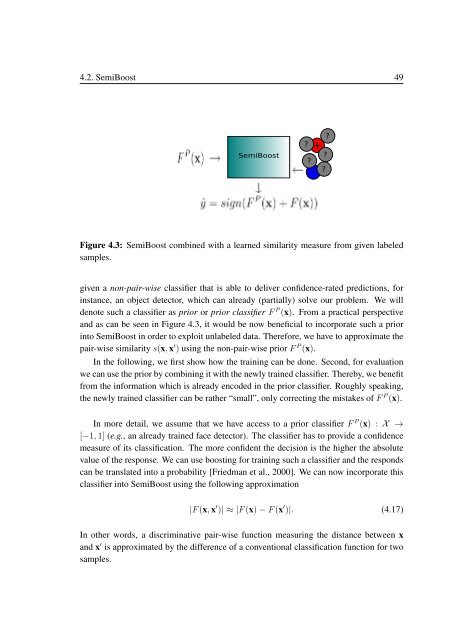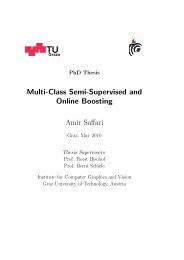PhD Thesis Semi-Supervised Ensemble Methods for Computer Vision
PhD Thesis Semi-Supervised Ensemble Methods for Computer Vision
PhD Thesis Semi-Supervised Ensemble Methods for Computer Vision
Create successful ePaper yourself
Turn your PDF publications into a flip-book with our unique Google optimized e-Paper software.
4.2. <strong>Semi</strong>Boost 49<br />
<strong>Semi</strong>Boost<br />
?<br />
?<br />
+<br />
-<br />
?<br />
?<br />
?<br />
Figure 4.3: <strong>Semi</strong>Boost combined with a learned similarity measure from given labeled<br />
samples.<br />
given a non-pair-wise classifier that is able to deliver confidence-rated predictions, <strong>for</strong><br />
instance, an object detector, which can already (partially) solve our problem. We will<br />
denote such a classifier as prior or prior classifier F P (x). From a practical perspective<br />
and as can be seen in Figure 4.3, it would be now beneficial to incorporate such a prior<br />
into <strong>Semi</strong>Boost in order to exploit unlabeled data. There<strong>for</strong>e, we have to approximate the<br />
pair-wise similarity s(x, x ′ ) using the non-pair-wise prior F P (x).<br />
In the following, we first show how the training can be done. Second, <strong>for</strong> evaluation<br />
we can use the prior by combining it with the newly trained classifier. Thereby, we benefit<br />
from the in<strong>for</strong>mation which is already encoded in the prior classifier. Roughly speaking,<br />
the newly trained classifier can be rather “small”, only correcting the mistakes of F P (x).<br />
In more detail, we assume that we have access to a prior classifier F P (x) : X →<br />
[−1, 1] (e.g., an already trained face detector). The classifier has to provide a confidence<br />
measure of its classification. The more confident the decision is the higher the absolute<br />
value of the response. We can use boosting <strong>for</strong> training such a classifier and the responds<br />
can be translated into a probability [Friedman et al., 2000]. We can now incorporate this<br />
classifier into <strong>Semi</strong>Boost using the following approximation<br />
|F (x, x ′ )| ≈ |F (x) − F (x ′ )|. (4.17)<br />
In other words, a discriminative pair-wise function measuring the distance between x<br />
and x ′ is approximated by the difference of a conventional classification function <strong>for</strong> two<br />
samples.



